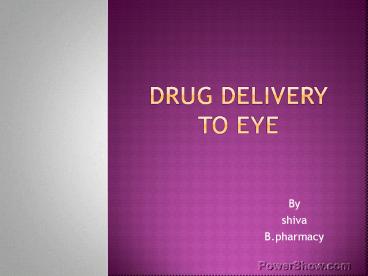opthalmic drug delivery system - PowerPoint PPT Presentation
Title:
opthalmic drug delivery system
Description:
opthalmic drug delivery system – PowerPoint PPT presentation
Number of Views:3968
Title: opthalmic drug delivery system
1
Drug delivery to eye
- By
- shiva
- B.pharmacy
2
Introduction
- Definition They are specialized dosage forms
designed to be instilled onto the external
surface of the eye (topical), administered inside
(intraocular) or adjacent (periocular) to the eye
or used in conjunction with an ophthalmic device. - Conventional ophthalmic dosage forms (solutions,
suspensions, ointments, etc) after instillation
into the eye, are rapidly drained away from the
ocular cavity due to tear flow and lacrimal nasal
drainage. - The newest dosage forms for ophthalmic drug
delivery are liposomes, nanoparticles
,mucoadhesives,ocular inserts.
3
- LIMITATIONS OF CONVENTIONAL DRUG DELIVERY
- Solution drainage by gravity
- Frequent instillation is necessary
- Conjuctival absorption
- ADVANTAGES OF AVANCED DUG DELIVERY
- Sustained and/or controlled drug release
- Site-specific targeting
- Protect the drug from chemical or enzymatic
hydrolysis - Increasing contact time and thus improving
bioavailability - Better patient compliance.
4
Parts of eye
5
Mechanism of absorption
6
Use of mucoadhesives in ocular drug delivery
- Mucoadhesives contain the dosage form which
remains adhered to cornea until the polymer is
degraded or mucus replaces itself. - Types-
- Naturally Occurring Mucoadhesives- Lectins,
Fibronectins - Synthetic Mucoadhesives-PVA ,Carbopol,
carboxymethylcellulose,cross-linked polyacrylic
acid - Drugs incorporated in to this are pilocarpine,
lidocaine, benzocaine and prednisolone acetate.
7
Mechanism of mucoadhesion
- The polymer undergoes swelling in water,
- Entanglement of the polymer chains with mucin on
the epithelial surface. - The un-ionized carboxylic acid residues on the
polymer form hydrogen bonds with the mucin. - The water- swellable yet water-insoluble systems
are preferred
8
Ocular inserts
- Sterile preparations, with a thin, multilayered,
drug-impregnated, solid or semisolid consistency
devices placed into cul-de-sac or conjunctival
sac. - Advantages
- Increasing contact time and thus improving
bioavailability. - Providing a prolong drug release and thus a
better efficacy. - Reduction of systemic side effects and thus
reduced adverse effects. - Reduction of the number of administrations and
thus better patient compliance.
9
Desired criteria for ocular inserts
- Ease of handling and insertion
- Lack of expulsion during wear
- Reproducibility of release kinetics (Zero-order
drug delivery) - Applicability to variety of drugs
- Non-interference with vision and oxygen
permeability. - Sterility.
- Ease of manufacture
10
(No Transcript)
11
Non erodible
- 1. Ocusert is a multilayered structure
consisting of a drug containing core surrounded
on each side by a layer of copolymer membranes
through which the drug diffuses at a constant
rate. - The rate of drug diffusion is controlled by
- The polymer composition
- The membrane thickness
- The solubility of the drug
- e.g. The Ocusert Pilo-20 and Pilo-40 Ocular
system - Designed to be placed in the inferior cul-de-sac
between the sclera and the eyelid and to release
pilocarpine continuously at a steady rate for
7days. - - consists of (a) a drug reservoir, pilocarpine
(free base), and a carrier material, alginic
acid (b) a rate controller ethylene vinyl
acetate (EVA) copolymer membrane.
12
- 2. Contact lens
- Presoaked Hydrophilic lens.
- Drug Release within 1st 30 Min.
- Alternate approach incorporate drug either as
soln or suspension .e.g. Pilocarpine. - Release rate is up to 180 hr.
13
Erodible
- 1. SODI (soluble ocular drug insert)
- Small water soluble made of soluble synthetic
polymers. - Composition Acryl amide, Vinyl Pyrolidone,
Ethylacrylate. - Weight 15-16 mg.
- In 10-15 sec Softens
- In 10-15 min. turns in Viscous Liquids
- After 30-60min. Becomes Polymeric Solution.
- ADVANTAGES
- Single SODI application replaces 4-12 eye drops
Instillation, or 3-6 application of Ointments. - Once a day treatment of Glaucoma.
14
- 2.Lacrisert
- Sterile, Rod Shaped device.
- Composition HPC.
- Weight5mg,
- DimensionDiameter12.5mm, Length3.5mm
- Use-Dry eye treatment.
- 3.Minidisc
- It is made up of counter disc with Convex front
Concave back surface in contact with eye ball. - 4-5mm in diameter.
- Composition Silicon based polymer.
- Drug release upto170 hr.
15
Liposomes
- Vesicle composed of phospholipid bilayer
enclosing aqueous compartment in alternate
fashion. - Biodegradable, Non-toxic in nature.
- Types 1.MLV
- 2.ULV-SUV( upto 100 nm)
- 3. LUV(more than 100 nm)
- Polar drugs are incorporated in aqueous
compartment while lipophilic drug are
intercalated into the liposome membrane. - Phospholipids used- Phophotidylcholine,
Phosphotidic acid, Phosphotidyleserine,Cardiolipi
ne
16
- ADVANTAGES
- Drugs delivered intact to various body tissues.
- Liposomes can be used for both hydrophilic and
hydrophobic drug. - Possibility of targeting and decrease drug
toxicity. - The size, charge and other characteristics can be
altered according to drug and desired tissue. - DISADVANTAGES OF LIPOSOMES
- They need many modification for drug delivery to
special organs. - Cost .
17
Nanoparticles
- For water soluble drugs
- Size is about 10-1000 nm
- Drug is dispersed, encapsulated or absorbed
- Produced by emulsion polymerization
- Polymerization is carried out by chemical
initiation, or by irradiation with gamma rays,
uv or visible light. - Polymer used are biodegradable.
- E.g Nanoparticles of pilocarpine have shown an
enhanced miotic response by about 22-23.
18
- Advantages of Nanoparticles
- Sustained drug release and prolonged therapeutic
activity - Site-specific targeting
- Higher cellular permeability
- Protect the drug from chemical or enzymatic
hydrolysis - Efficient in crossing membrane barriers -blood
retinal barrier - Act as an inert carrier.
19
THANK YOU Shiva.pharmacist_at_gmail.com































